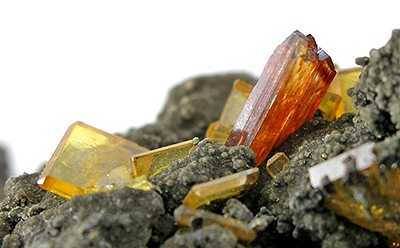The Mineral raspite

Raspite is a rare dimorph of the mineral Stolzite. In its most prolific locality of Broken Hill, Australia, Raspite almost always occurs together with Stolzite, with the Raspite more deeply colored and elongated than the Stolzite. Raspite is named after Charles Rasp (1846-1907). Rasp was credited for discovering the famous Broken Hill deposit, which is the type locality for this mineral and has produced its best examples.
Color
Yellow, orange, brown. Rarely gray to white.
Crystal System
Monoclinic
Crystal Habits
Crystals are prismatic or flatenned tabular. They are always small in size and usually striated lengthwise. Raspite crystals may be twinned in crude v-shaped twins.
Uses
Raspite is a very rare and valuable collectors mineral.
Noteworthy Localities
The most famous locality of Raspite, where it was first described, is Broken Hill, New South Wales, Australia. Other localities where this mineral is found in micro crystals are the Cordillera Mine, Tuena, New South Wales, Australia; the Ameib Farm, Erongo Mountains, Namibia; the Clara Mine, Oberwolfach, Baden-Württemberg, Germany; and Les Montmins, Auvergne, France.
Common Mineral Associations
Stolzite, Scheelite, Limonite, Goethite, Mottramite